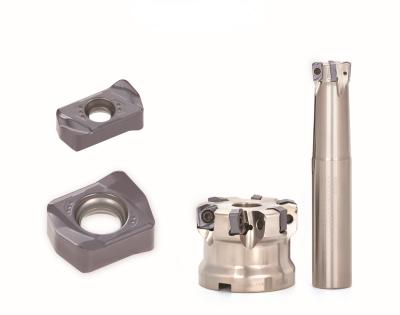
Tungaloy is expanding its DoFeed line of high-feed milling cutters to include AH3225 grade inserts. DoFeed is a high-feed milling cutter series with a close-pitched insert alignment, addressing various application needs where an efficient removal of large stock is required.
AH3225 is Tungaloy’s latest development of the first-choice grade for steel machining. The grade has a nano-multilayer PVD coating consisting of three distinctive layers. This coating configuration adds multifunctional characteristics to the grade, including wear and fracture resistance, as well as eliminating built-up edge and delamination.
A tough carbide substrate with enhanced thermal shock properties can prevent the catastrophic insert failure induced by severe thermal stress. In addition, AH3225 eliminates unwanted abnormal wear modes such as coating delamination and micro edge-chipping, which takes place at the very initial moments of the cutting, while impeding the progression of normal flank wear, providing all characteristics required for the grade to enable long and predictable tool life in steel milling operations.
Contact Details
Related Glossary Terms
- built-up edge ( BUE)
built-up edge ( BUE)
1. Permanently damaging a metal by heating to cause either incipient melting or intergranular oxidation. 2. In grinding, getting the workpiece hot enough to cause discoloration or to change the microstructure by tempering or hardening.
- flank wear
flank wear
Reduction in clearance on the tool’s flank caused by contact with the workpiece. Ultimately causes tool failure.
- gang cutting ( milling)
gang cutting ( milling)
Machining with several cutters mounted on a single arbor, generally for simultaneous cutting.
- milling
milling
Machining operation in which metal or other material is removed by applying power to a rotating cutter. In vertical milling, the cutting tool is mounted vertically on the spindle. In horizontal milling, the cutting tool is mounted horizontally, either directly on the spindle or on an arbor. Horizontal milling is further broken down into conventional milling, where the cutter rotates opposite the direction of feed, or “up” into the workpiece; and climb milling, where the cutter rotates in the direction of feed, or “down” into the workpiece. Milling operations include plane or surface milling, endmilling, facemilling, angle milling, form milling and profiling.
- milling cutter
milling cutter
Loosely, any milling tool. Horizontal cutters take the form of plain milling cutters, plain spiral-tooth cutters, helical cutters, side-milling cutters, staggered-tooth side-milling cutters, facemilling cutters, angular cutters, double-angle cutters, convex and concave form-milling cutters, straddle-sprocket cutters, spur-gear cutters, corner-rounding cutters and slitting saws. Vertical cutters use shank-mounted cutting tools, including endmills, T-slot cutters, Woodruff keyseat cutters and dovetail cutters; these may also be used on horizontal mills. See milling.
- physical vapor deposition ( PVD)
physical vapor deposition ( PVD)
Tool-coating process performed at low temperature (500° C), compared to chemical vapor deposition (1,000° C). Employs electric field to generate necessary heat for depositing coating on a tool’s surface. See CVD, chemical vapor deposition.

